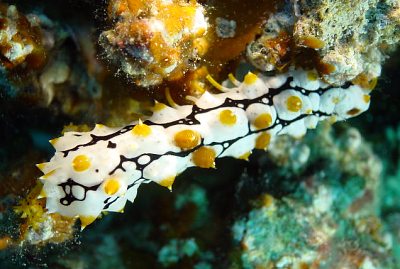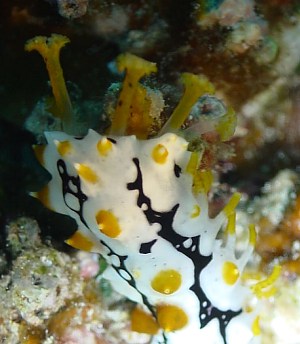Re: Phyllidia varicosa mimic
March 24, 2003
From: Marina Poddubetskaia

Dear Ros,
Concerning your query about Bohadschia graffei juveniles as a mimic of Phyllidia varicosa. Recently, I had a diving cruise to Brothers Islands, in the Red Sea. Near Safaga I found this juvenile Bohadschia graeffei. It was just on a hard coral.
It seems that it mimics Phyllidia varicosa but there were very few nudibranchs there and I didn’t see any blue phyllidiid with yellow tubercles. I hope this record will help you in your research.
Date: February 09, 2003
Location: Safaga, Egypt, Red Sea
Site: Panorama Reef
Depth: 10m
Size: 65-70mm
Photos: Marina Poddubetskaia - Nembro website
Best wishes,
Marina.
nembro@nembro.info


Dear Marina,
Thanks for these wonderful photos of the holothurian Bohadschia graeffei. To those with little knowledge of holothurians or sea cucumbers, the lower left photo shows the tube feet (yellow) very well. These are the same organs which enable it, and its close relatives, the starfish and sea urchins, to 'walk'. The lower right photo shows the circlet of oral feeding tentacles around the mouth which enables it to collect the detritus and organic matter it eats, from the substrate.
Now I have finished the anatomy lesson here is a comment on mimicry and your bservation that there were no 'models' - that is blue and yellow phyllidiids around. Mimicry is quite difficult to prove, and I am sure some similar colour patterns have evolved by chance, or the predators who are supposedly fooled by the trickery can't see the colours. But with that caution, there are certainly many examples of remarkable mimicry. I don't know whether the juvenile holothurian is mimicking phylidiids, but if it is then the mimicry would have evolved over a long time period. It is certainly n necessary for model and mimic to be around together at all times,
Best wishes,
Bill Rudman
Related messages
-
Holothurian phyllidiid mimic
From: Valérie Besnard, May 18, 2005 -
Flatworm mimic of Chromodoris magnifica
From: Mary Jane Adams, January 19, 2004 -
Bohadschia / Pearsonothuria
From: Bob Bolland, January 8, 2004 -
Bohadschia graffei as mimic of Phyllidia varicosa
From: Rosalind Day, October 17, 2003 -
Phyllidia varicosa mimic
From: Rosalind Day, November 15, 2002 -
Phyllidia mimicry
From: Erwin Koehler, May 18, 2002 -
Why do some nudibranchs share the same colour patterns?
From: joe, March 13, 2002 -
Nudibranch & Flatworm mimicry
From: Adam Brown, March 5, 2002 -
Is this fish a Sea Slug Mimic?
From: Mark McGrouther , May 2, 2000 -
Holothurian Phyllidia mimic
From: Wolfgang Seifarth, December 21, 1999 -
About Mimicry & flatworms
From: Christine, July 11, 1999 -
Mimicry topic continued
From: Michael D. Miller, April 15, 1999 -
Mimicry revisited
From: Mike Miller, April 7, 1999 -
Mimicry: Flatworm & C. geometrica
From: Michael Miller, January 15, 1999 -
More Phyllidiella mimic pics
From: Michael Miller , December 3, 1998 -
A case of mimicry
From: Wayne Ellis, June 25, 1998
